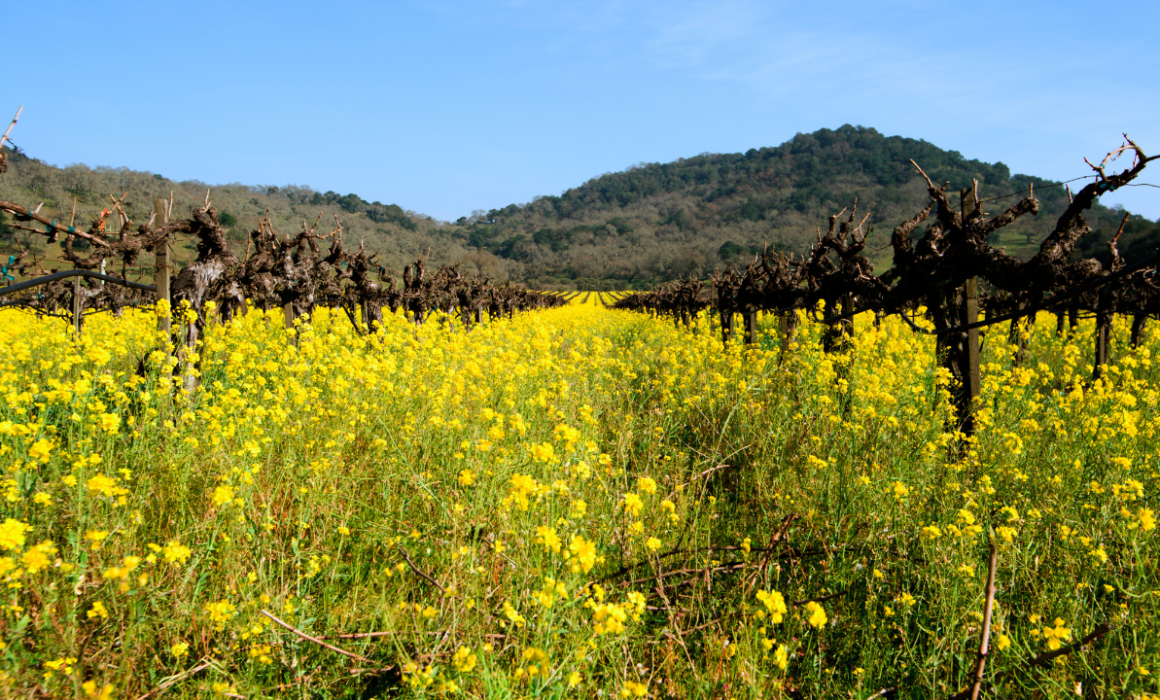Sonoma County Mustard in Bloom
By Virginie Boone
Sonoma County is in peak mustard season right now and that makes it a gorgeous time to take in the bright yellow bloom of mustard flowers in vineyards and fields, from the cool climes of Carneros to warmer Alexander Valley and out toward the Sonoma Coast.
The benefits of mustard are many – biofumigants within the plant suppress microscopic worms that can damage vines; provide nutrients; fight erosion; recycle and redistribute nitrogen; and break up clayey soils. Mustard can contribute to a sustainable vineyard system.
Field mustard, as it’s called, is a member of the mustard or Brassicaceae family and related to several types of turnip, broccoli raab and Italian kale. Originated in Eurasia, it now exists all over the world and is naturalized in North America, able to grow from sea level to 5,000-feet elevation. It loves cultivated fields, gardens and orchards, but also roadsides and ditches, particularly if there’s well-drained, moist soil to settle in. Most mustard blooms just after hearty rain.
Father Junipero Serra and other Franciscan missionaries are thought to have introduced mustard to California, bringing mustard seeds from Spain to use as landscaping, dropping them along El Camino Real to mark the path from mission to mission like a “ribbon of gold.”
A total of 21 missions were established between 1769 and 1823, starting in San Diego and ending in Sonoma, designed to be spread apart one day’s ride by horse, about 30 miles. Plans for a 22nd mission in Santa Rosa were canceled in 1827.
The further spread of mustard is traced back to the Gold Rush era, when demand for beef increased substantially, and wildlands were converted to pastures. As detailed in a PBS SoCal story, Professor Thomas Gillespie from UCLA traced a link between historic grazing sites and the spread of mustard.
Farmers love mustard as a winter annual cover crop for preventing erosion, suppressing weeds and soil-borne pests as well as for alleviating soil compaction. Many spread plant-based compost throughout their vineyards just after harvest, adding organic matter and nutrients to the soil, with mustard seeds often in the mix.
According to its description by the United States Department of Agriculture’s Natural Resource Conservation Service’s Plant Guide, “it appears to be a good tool as a biofumigant cover crop for control of nematodes, soil-borne diseases including the fungal pathogen responsible for damping-off, weeds and other pests.”
But it can also displace vegetation if not managed well. When it works, it grows until bud break, when the vines wake up from winter and the mustard plants are turned into mulch for the grapevines.
Beyond grapevines, mustard is considered one of the world’s most important spices, just after salt and pepper, and the making of it traditionally involves wine, which is used to crush and melt mustard seeds into a paste.
Brassica nigra, or Black mustard, is thought to be the first species of mustard to be harvested as a spice, and there are records of its use going as far back as the Bronze Age in Europe, China 5000-4000 BC and to the earliest dynasties of Egypt. It became an important currency to spice traders, and the Romans later introduced the concept of mustard manufacture, combining the seeds with grape juice, vinegar and honey, to France and England.
In addition to black mustard, we also now have seeds that produce brown and yellow mustards.
Get out there and enjoy this beautiful time of year in Sonoma County and consider that this plant has thrived in California for more than 250 years.


